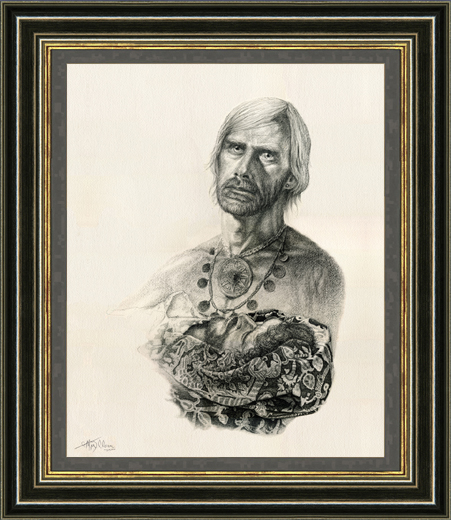This
1977 pen and ink drawing, entitled Death of Hephaestion by Mulleian was inspired
by unusual circumstances surrounding Robert Arbegast (a close companion to Mulleian).
In one of Robert Arbegast's visits to the artist's studio one afternoon, he
engaged with Mulleian in one of their intense discussions, not realizing that
he would become the model for this powerful drawing. As they stood next to one
of the studio windows Mulleian was suddenly mentally transported in time as
he was witnessing the changing effects of geometrical shapes of light and shadow
that appeared across Arbegast's face, creating a dramatic metamorphosis captured
by Mulleian's eye which would inspire him in the creation of this drawing.
Alexander
the Great walks past his generals holding Hephaestion, wrapped in ornate fabric,
the warrior's grief-stricken face revealing the panoramic realization of the
death of his close companion. Here in this powerful drawing, as in many of his
works, Mulleian is able to capture many layers of emotion, sanctioned by providential
moments contained in a dramatic theme. By slowing down time the artist seems
to pluck out moments well hidden in history, and foretell warnings transposed
in the future.
In
The Death of Hephaestion, (for which Arbegast modeled for both Alexander and
Hephaestion) Mulleian once again creates composition within supporting composition
and leaves the viewer no retreat from a single
point , the essence of which the artist is conveying peripherally through the
powerful personality and profoundly tortured feelings of loss, vulnerability
and despair, all concentric elements converging within the intensely focused
energy staring directly at the viewer through the eyes of Alexander the Great.
These combined elements force the emotions of the viewer and compel thought.
Mulleian's
Clairvoyance
and the
Future
In
the drawing Death Of Hephaestion and in many of his other works, Mulleian seems
to depict events long before they occur. The artist's foresight seems to come
from a deep intuitive force within him, foreseeing events such as weather conditions,
longevity of relationships,
and political and social calamities. The drawing Death Of Hephaestion is a prime
example of Mulleian's uncanny clarvoyance. In 1977 Robert Arbegast was used
as the model for both Alexander (holding the remains of his companion),
and Hephaestion (in repose on an ornate shroud in the arms of Alexander). Some
30 years later it would be Mulleian who would be placing the cremated remains
of Robert Arbegast in an urn which was resting on the very same ornately patterned
cloth that had been used as the model for Hephaestion's shroud in the original
drawing. Also read Metallic Sound by Mulleian.
In
another piece, a 1971 painting entitled The Window, Mulleian depicts a note
written on a torn piece of paper left on a window sill describing the breakup
of a couple two years, in fact, before the breakup actually occurred. And again,
Mulleian's implicit despair rendered in the powerful painting entitled Dies
Irae envisions nuclear disaster, yet also conveys the possibilities of hope,
symbolized by an eagle flying toward the nuclear light. Mulleian had expressed
many times before "Predictions are warnings to mankind and can be changed. Prophecies,
on the other hand, are preordained and, therefore, cannot be changed."
